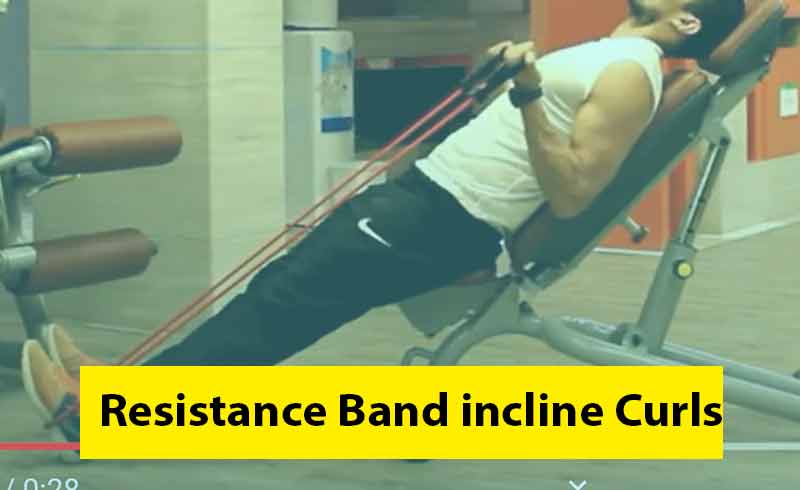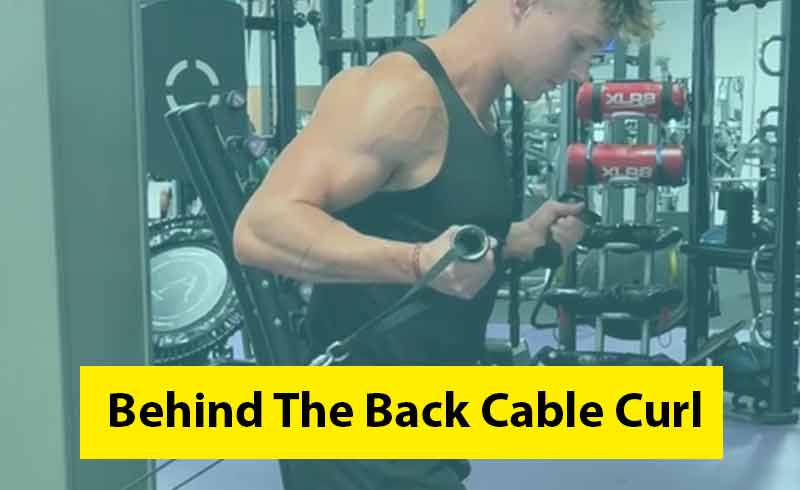A muscle with two heads, like the biceps. Thus, training both heads during an arm workout is necessary for the biceps’ entire development.
The long head of the biceps is emphasized by the behind the back cable curl, and in particular, the long head when it is extended.
It’s the polar opposite of the standard cable curl, which emphasizes the small head since the arms are normally held somewhat in front of the torso.
If you want to maximize your bicep growth, you should think about including both options in your workout routine.
Related: Cable Concentration Curls
Exercise Details
- Also known as: Behind the body cable curl
- Exercise type: Strength Type
- Body type: Arms
- Level: Intermediate
- Main targets: Biceps brachii
- Secondary targets: Brachialis, brachioradialis, and forearms
- Compound/Isolated: Isolated
- Force type: Pull
- Required equipment: D-handles & Cable machine
What is Behind The Back Cable Curl
In order to increase bicep size and strength, try doing cable curls behind your back.
Pulling a load behind your back forces you to hold your elbows back, which puts more stress on your biceps.
This kind of curl puts your biceps under continual stress, makes it harder to cheat, and speeds up the process of building big, strong muscles.
How To Do Behind The Back Cable Curl
1- Attach a D-handle or stirrup device to a low pulley.
2- Pick up the handle and turn your back on the cable terminal.
3- Move away from the machine until the cable is tight and your arms are dragged slightly behind your body. stretch your arm behind your back.
4- Flex your elbow to bring the cable grip up toward your shoulder, Hold the contraction for one to two seconds.
5- Tighten your biceps, then slowly drop the weight until your elbow is nearly locked.
6- You need to do 3–4 sets of 10-15 repetitions for each arm.
Behind The Back Cable Curl Muscles Worked
Biceps brachii is known as the brachial, brachioradialis, and Forearms, triceps, and deltoids
The biceps brachii muscles get the most from this exercise. The scapula and radius of the forearm are connected by the same set of muscles that allow us to bend our elbows.
During performing a curl, the brachialis, brachioradialis, and biceps all work together to keep the elbows stable.
The shoulder and upper back muscles (deltoids, trapezius, levator scapulae), as well as the abdominals, are used to maintain stability throughout the curls’ continual tension and motion.
Once pulleys became commonplace in commercial gyms, they starred in many arm-muscles routines.
Because of its adaptability to a variety of muscle groups, it is a classic in bodybuilding routines for developing strong and attractive arms, chests, and backs.
Strength in the arms helps with sports training and makes everyday tasks simpler, regardless of how you feel about your appearance.
Behind The Back Cable Curl Benefits
1. Increases Muscle Size and Strength
The biceps and forearms benefit greatly from behind-the-back cable curls. With a combination of these muscles, you may create a motion that enables you to target your biceps from a wide range of angles.
Even if we exclude the purely cosmetic benefits, having strong and muscular arms helps you do routine tasks and excel in sports maneuvers.
2. Maintains Constant Resistance
Because of the increased resistance until the completion of the exercise, even when employing a reasonably heavyweight, cable workouts are safer than free-weight exercises.
Moreover, you can change the degree of difficulty on cable machines, so they may be used by persons of varying fitness levels.
In many cases, those with physical restrictions may still benefit from cable workouts by modifying the movements to their own needs.
3. Allows for Optimal Blood Flow
Enhanced blood flow is another key benefit of behind-the-body cable curls.
Overuse injuries to muscles, tendons, and ligaments may be avoided with its aid, maintaining continual motion improves muscle recovery by increasing blood flow.
Behind The Back Cable Curl Alternatives
1. Incline Dumbbell Curls

Strengthen your arm muscles one at a time with the incline dumbbell curl, an isolation movement. Sit on an incline bench that is inclined to 45 or 60 degrees and do dumbbell curls.
Get a set of dumbbells and keep them by your side. Lift the dumbbells to shoulder height by squeezing your biceps and bending your elbows. You may do as many or as few repetitions as you want.
2. Resistance Band Incline Curls

If you want to simulate the classical incline curl as closely as possible while utilizing bands, incline bench band curls are the way to go.
To do this, find an incline bench, raise its back pad to a 60-degree inclination, and sit on the seat.
To keep the band from sliding when seated, just position your feet in its center. Maintain a supinated hold on both ends of the band. You should stretch out on the bench.
To perform the first part of the rep, curl the band toward your front delts. Once your biceps reach the insides of your forearms, give them a good squeeze, and then slowly release the band till your elbows are completely extended.
3. Incline Cable Curls

The Incline Cable Curl is a good way to build up the muscles in your biceps and forearms.
The best time to do Incline Cable Curls is after doing a free weight biceps exercise like EZ Bar Curls or Barbell Curls.
If you use light weights and pay attention to your form and technique, you’ll get better results from this exercise.
Conclusion:
The behind-the-back cable curl isn’t as popular as its free-weight exercises, but in many ways, it’s better for building muscle than barbells or dumbbells.
There is constant tension throughout the entire set. Because your biceps don’t get a chance to recuperate, so, you get a stronger muscle pump.
If you want to strengthen your mind-muscle connection, it’s best to stick to sets of 12 to 20. But, if you’re satisfied in your form, go ahead and do sets of 6-10 repetitions to isolate your fast-twitch muscle tissue.
References:
- Evans, M. (2016, April 29). Why you need to use cable machines. Men’s Health. https://www.menshealth.com/uk/building-muscle/a755943/why-you-need-to-use-cable-machines/
- Moon J, Shin I, Kang M, et al. The Effect of Shoulder Flexion Angles on the Recruitment of Upper-extremity Muscles during Isometric Contraction. J Phys Ther Sci. 2013;25(10):1299-1301. doi:10.1589/jpts.25.1299
- Bench Press Calculator - April 22, 2024
- Press to Handstand: Ultimate Step-by-Step Guide - April 22, 2024
- Cable Press (How To Do, Benefits, Targeted Muscles, Alternative) - April 22, 2024

